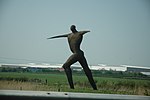King's Sedgemoor Drain

King's Sedgemoor Drain is an artificial drainage channel which diverts the River Cary in Somerset, England along the southern flank of the Polden Hills, to discharge into the River Parrett at Dunball near Bridgwater. As the name suggests, the channel is used to help drain the peat moors of King's Sedgemoor. There was opposition to drainage schemes from the local inhabitants, who feared that they would lose their common grazing rights. However, the main channel was constructed between 1791 and 1795, and despite some defects, brought some relief from flooding to the area. The drain was upgraded during the Second World War, to provide a backup water supply for an armaments factory at Puriton, and again in 1972, when the Sowy River flood relief channel was built. The drain has hosted the National Fishing Championships, as it is well-stocked with fish, and is also an important haven for birds.
Excerpt from the Wikipedia article King's Sedgemoor Drain (License: CC BY-SA 3.0, Authors, Images).King's Sedgemoor Drain
Bristol Road,
Geographical coordinates (GPS) Address Nearby Places Show on map
Geographical coordinates (GPS)
| Latitude | Longitude |
|---|---|
| N 51.161666666667 ° | E -2.9886111111111 ° |
Address
Bristol Road
Bristol Road
TA6 4TN
England, United Kingdom
Open on Google Maps










